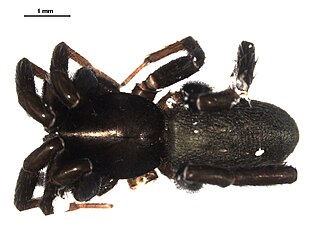
Spilotes sulphureus, commonly known as the yellow-bellied hissing snake or Amazon puffing snake, is a species of venomous snake in the family Colubridae. It is widely distributed throughout South America, as well as the Caribbean island of Trinidad.

Phrynonax poecilonotus is a species of nonvenomous snake in the family Colubridae. The species is endemic to the New World.

A species that is extinct in the wild (EW) is one that has been categorized by the International Union for Conservation of Nature as only consisting of living members kept in captivity or as a naturalized population outside its historic range. Classification requires exhaustive surveys conducted within the species' known habitat with consideration given to seasonality, time of day, and life cycle. Once a species is classified as EW, the only way for it to be downgraded is through reintroduction.
Gastrotheca pseustes is a species of frog in the family Hemiphractidae. It is endemic to Ecuador. Its natural habitats are subtropical or tropical moist montane forests, subtropical or tropical high-altitude shrubland, subtropical or tropical high-altitude grassland, rivers, freshwater marshes, intermittent freshwater marshes, pastureland, and heavily degraded former forest. It is threatened by habitat loss.

The Somali hedgehog is a species of mammal in the family Erinaceidae. It is endemic to Somalia and Somaliland. The Somali hedgehog is nocturnal.

The pale gray shrew is a species of mammal in the family Soricidae. It is endemic to Pakistan and is distributed in the Shigar valley and the western edge of Deosai.

Granulina is a genus of minute sea snails, marine gastropod mollusks or micromollusks in the family Granulinidae.
†Helenoconcha leptalea is an extinct species of small air-breathing land snails, terrestrial pulmonate gastropod mollusks in the family Charopidae.
Helenoconcha is a genus of small air-breathing land snails, terrestrial pulmonate gastropod mollusks in the family Charopidae endemic to the island of Saint Helena, hence the genetic epithet. All species save for H. relicta, are extinct.
Helenoconcha polyodon was a species of small air-breathing land snails, terrestrial pulmonate gastropod mollusks in the family Charopidae.
†Helenoconcha sexdentata was a species of small air-breathing land snails, terrestrial pulmonate gastropod mollusks in the family Charopidae.
The Ammonite Snail is a species of small air-breathing land snails, terrestrial pulmonate gastropod mollusks in the family Charopidae. The species is endemic to Saint Helena Island, and is the only Helenoconcha species remaining.

Pseustes was a genus of snakes of the family Colubridae.

Zelotes pseustes is a species of ground spider in the family Gnaphosidae. It is found in the United States and Mexico.

Endangered species, as classified by the International Union for Conservation of Nature (IUCN), are species which have been categorized as very likely to become extinct in their known native ranges in the near future. On the IUCN Red List, endangered is the second-most severe conservation status for wild populations in the IUCN's schema after critically endangered. In 2012, the IUCN Red List featured 3,079 animal and 2,655 plant species as endangered worldwide. The figures for 1998 were 1,102 and 1,197 respectively.








